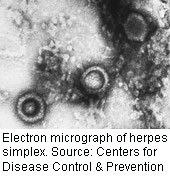
TUESDAY, March 9 (HealthDay News) — As many as one in six Americans is infected with herpes simplex virus type 2 (HSV-2), health officials said Tuesday.
HSV-2, one of the most common sexually transmitted diseases (STDs) in the United States, is a serious, incurable infection that lasts a lifetime, causing recurrent and painful genital sores, according to the U.S. Centers for Disease Control and Prevention.
“Preventing STDs is a public health challenge that we, as a nation, cannot afford to ignore,” Dr. Kevin Fenton, director of the CDC’s National Center for HIV/AIDS, Viral Hepatitis, STD and TB Prevention, said Tuesday during a news conference.
The CDC estimates that 19 million new STD infections occur every year in the United States, almost half of them among young people, Fenton added.
“Young women, African Americans, and gay and bisexual men are especially hard hit,” he said. “It is unacceptable that STDs remain such a widespread public health problem in the United States today.”
The new findings on herpes, which were presented at the agency’s 2010 National STD Prevention Conference, represent data from the 2005 to 2008 National Health and Nutrition Examination Survey, which involves households from across the country.
The prevalence of HSV-2 has remained stable, at about 17 percent of the U.S. population, since the last survey, which was done from 1999 to 2004.
“This stabilization in herpes rates follows a period of declining prevalence, down from 21 percent for the years 1988 to 1994,” La’Shan Taylor, an officer with the CDC’s Epidemic Intelligence Service and author of the report, said during the news conference.
According to the report, women and blacks are the most likely to be infected. In fact, the prevalence among women was 20.9 percent, nearly twice that of men, at 11.5 percent.
Among blacks, 39.2 percent are infected, a rate more than three times that of whites, at 12.3 percent, according to the report. Black women had the highest prevalence of HSV-2, at 48 percent.
“As dark as these numbers are, they are not substantially different from CDC’s previous estimates of these populations,” Taylor said.
The report noted that women also are more susceptible to other sexually transmitted diseases and that the racial disparities found with HSV-2 may be due to more infections among blacks that make them more likely to be exposed to herpes.
The infection rates should also be considered serious because people with herpes are two to three times more likely to become infected with HIV and because having herpes makes it more likely that an HIV-infected person will give HIV to others, according to the CDC.
Taylor said the survey also found that the prevalence of herpes increases with age, from 1.4 percent among those aged 14 to 19 years to 26.1 percent among people aged 40 to 49. “This reflects the fact that, once you are infected with herpes, the infection is lifelong since no cure currently exists,” she said.
The prevalence of herpes was also higher among those who reported having many sex partners, Taylor said. About 4 percent of those with one lifetime sex partner were found to have herpes, compared with about 27 percent of those who reported having 10 or more partners.
In addition, more than 80 percent of people infected with herpes don’t know they are infected, Taylor said, in large part because symptoms can be mild or absent altogether. Symptoms also are often taken to be the sign of another infection.
But people with herpes infection can transmit it to others even if they have no signs of the disease, health officials stressed.
“This latest analysis emphasizes that we can’t afford to be complacent about this infection,” Dr. John M. Douglas Jr., director of CDC’s division of STD prevention, said during the news conference.
“It is important that we promote steps to prevent the spread of genital herpes, not only because herpes is a lifelong and incurable infection but also because of the linkage between herpes and HIV infection.”
Dr. David L. Katz, director of the Prevention Research Center at the Yale University School of Medicine, described herpes as a “bellwether for sexually transmitted diseases … because it suggests that other such exposures may have occurred and because it increases vulnerability when they do.”
“Unfortunately, we have no perfect defense against herpes since it cannot be cured and there is, as yet, no vaccine,” Katz said. Though he predicted that a vaccine would eventually be developed, increased diligence is needed in the meantime, he added.
That should include “heightened awareness among both clinicians and patients, routine dialogue on the topic in all primary care settings, guidance to all patients on prevention strategies and routine availability of condoms and other barrier contraceptive devices,” Katz said.
“The high prevalence of herpes, and the disparities with which it is associated, indicate we can do this job better and more equitably,” he said.
Though there is no cure for HSV-2, drugs can be effective in treating and preventing outbreaks, according to the CDC. However, the agency recommends not having sex during an outbreak, using condoms and limiting the number of sex partners.
Although the CDC does not recommend that people generally be screened for herpes, it says that those at high risk for the infection might want to be screened. They include people with multiple sex partners, those who are HIV-positive, and gay or bisexual men.
Another report presented at the STD conference focused on why young women, no matter what race, appear to be reluctant to be tested for STDs.
Heather Royer, of the University of Wisconsin-Madison, surveyed 302 women, 18 to 24 years old, about their beliefs about STD testing. She found that barriers to testing included:
- The majority of women (88 percent) were uncomfortable being tested by a man.
- Most women (79 percent) would prefer being tested by a specialist, not a family doctor.
- Many women (62 percent) were generally anxious about being tested.
- Some women (31 percent) were concerned that the test results would appear in their medical record.
In addition, many women had misconceptions about testing, Royer’s survey found. About 40 percent thought that one test could detect as many as eight STDs, though that is not the case; about one-third incorrectly thought that chlamydia and gonorrhea could be found simply by visual inspection; and 25 percent mistakenly believed that a Pap smear could detect chlamydia and gonorrhea.
Moreover, women who said they were embarrassed to talk about sex with their doctors or fill out questionnaires about their sexual history were twice as likely to have never had an STD test, the survey found.
To reduce the stigma of STDs, Royer said that doctors should be encouraged to make sexual history part of routine care for young women.
More information
The U.S. Centers for Disease Control and Prevention has more on sexually transmitted diseases.

